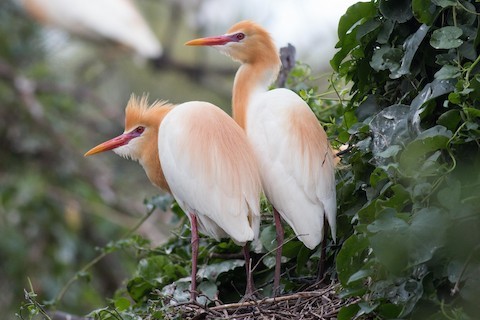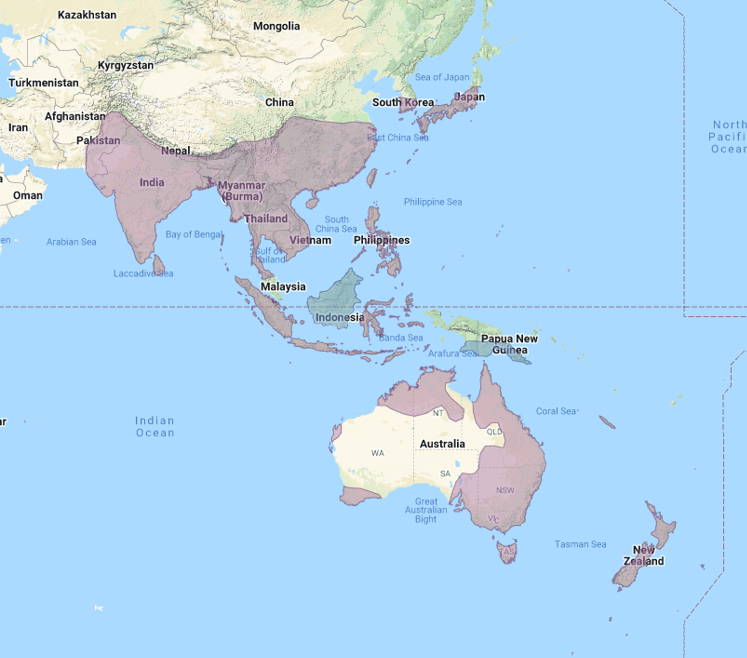Birdfinding.info ⇒ Common and conspicuous in fields and marshes from Pakistan and China to Tasmania. In New Zealand it is mostly a winter visitor, from March to October or so. Consistent sites there include Kaipara Harbour, Rangiriri, Lake Ellesmere, Tasman Bay, and Inch Clutha.
Eastern Cattle Egret
Bubulcus coromandus
Family: Ardeidae
South Asia and East Asia to New Zealand.
Often associated with grazing livestock, but also occurs in other open terrestrial and aquatic habitats. Its range has expanded due to the large-scale development of open agricultural and urban spaces. Mostly resident overall, but local populations—most noticeably at the margins of its range—are partly migratory, nomadic, or dispersive.
Widespread in Asia south and east of the Himalayan uplift, west to the Indus River plains and delta in Pakistan and north locally to northern China (to Qinghai and southern Liaoning), North Korea, and central Honshu.
In central and eastern Asia, wanderers occur sporadically north to Xinjiang, Mongolia, Heilongjiang, Primorskiy Kray, Hokkaido, and the southern Kuril Islands. West of Pakistan, stragglers are regularly recorded from the Arabian Peninsula, mainly Oman and the U.A.E.

Eastern Cattle Egret (at right) with Western Cattle Egrets, all in breeding plumage—a few Eastern stragglers occur on the Arabian Peninsula, where they mingle with the resident Western population. Despite the appearance in this photo, leg color is not diagnostic. (Wamm Farms, Fujairah, United Arab Emirates; April 22, 2011.) © Khalifa Al Dhaheri
To the south and east, it is widespread across the Ryukyu Islands, Taiwan, the Philippines, Palau, Indonesia, New Guinea, New Britain, Australia, Tasmania, and sparingly to New Zealand.
Expansion across Australasia occurred during the 1900s. It was first noted in New Guinea in 1941, Australia in 1948, and New Zealand in 1963. By the 2000s it was well-established essentially throughout Australia and Tasmania, wherever suitable habitat exists—extensively in the north and east, and more locally in the west, south, and deep interior.
Regular as a nonbreeding visitor south to New Zealand—but the numbers recorded there declined sharply from a peak of over 3,200 in the late 1980s to dozens or low hundreds in the 2000s.
Wanderers are regularly encountered on various smaller and more remote islands of the tropical western Pacific—especially in Micronesia, where it appears to have colonized the Izu Islands and the Marianas, and has been reported from many of the Caroline Islands. There are more isolated records from New Caledonia, the Solomons, Fiji, and the Northwest Chain of Hawaii (where it has been confirmed at least once each on Midway and French Frigate Shoals, among the more expected Western Cattle Egrets which wander there from the main Hawaiian Islands).
Identification
A small, compact, mostly terrestrial, white heron with a stout, orange or yellow, daggerlike bill. Strongly associated with large, grazing mammals, including cattle, which it often accompanies and sometimes rides. It specializes in capturing grasshoppers and other prey disturbed by mammalian companions.

Eastern Cattle Egret in breeding plumage. (Ballina, New South Wales, Australia; December 10, 2016.) © Hans Wohlmuth
Extremely similar to the closely related Western Cattle Egret. Eastern averages slightly larger and proportionately longer-billed than Western, but they are reliably distinguished only by differences in breeding plumage.
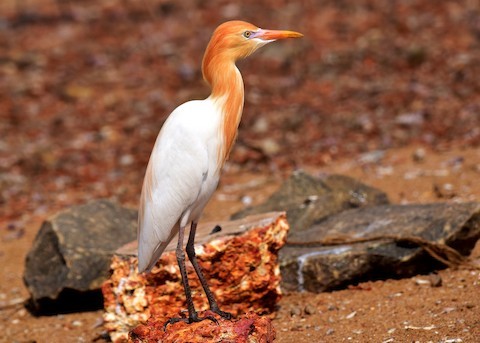
Eastern Cattle Egret in breeding plumage—maximally orange. (Ponnani Beach, Malappuram, Kerala, India; May 3, 2018.) © Mathew Thekkethala
In breeding plumage, the otherwise plain-white plumage is augmented by shaggy, buffy-orange feathers on the head, neck, and chest, and long, wispy, buffy-orange ornamental plumes on the back. Differs from Western’s breeding plumage in the extent of buffy-orange plumage throughout the face and neck. Also tends to attain richer shades of orange than Western—although the coloration of both varies seasonally and individually.
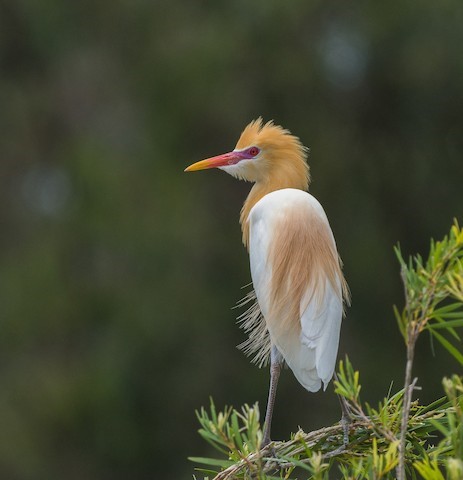
Eastern Cattle Egret in breeding plumage with full flush coloration of the bill and facial skin. (Jesse Wickman Park, Minden, Queensland, Australia; October 24, 2021.) © David Southall
In peak breeding flush, the bill and facial skin are multicolored: yellow-orange toward the tip, becoming red toward the base, then shading to purple on the lores, with orange or red eyes.
Nonbreeding plumages are all-white. The bill is yellowish.

Eastern Cattle Egret in nonbreeding plumage. (Gaomei Wetland, Taichung, Taiwan; January 1, 2021.) © Yu-Wei Lee
In all plumages, the legs vary from orange to purplish to gray to black. Breeding adults often show orange or purplish legs, and nonbreeding birds more typically have black legs.
In flight, holds its head far back, creating a bulging, rounded keel when viewed in silhouette.

Eastern Cattle Egret in nonbreeding plumage, showing flight silhouette with bulging keel. (Balinsasayao Road, San Jose, Negros, Philippines; January 24, 2020.) © Chris Chafer
Notes
Monotypic species. Traditionally considered conspecific with the Western Cattle Egret (ibis), known collectively as the Cattle Egret (ibis).
The status of these forms as either separate species or distinctive subspecies is debatable, but the trend since the early 2000s has been toward recognition as two species. They are highly mobile and have been observed to overlap regularly (on the Arabian Peninsula), yet their populations apparently remain distinct—readily detectable only in breeding plumage. Genetic markers reportedly indicate substantial, long-term divergence of their populations, which would be unlikely in this scenario unless they effectively distinguish between themselves as different.
See below for a comparison of the Western and Eastern Cattle Egrets with the Intermediate Egret.
Cf. Intermediate Egret. Western and Eastern Cattle Egrets overlap with the three forms of Intermediate Egret across most of Africa, southern and eastern Asia, and Australasia. Cattle Egrets are far more likely to be found in dry habitats, but both are found in aquatic habitats—especially in open marshes and rice fields. In their nonbreeding plumages, all have pale yellowish bills of approximately the same length, pale eyes, all-white plumage, and somewhat variable, usually blackish legs. The differences between them are subtle and mostly unreliable for identification.
Cattle Egrets are shorter and thicker, and tend to appear hunched, whereas Intermediate Egrets usually appear proportionately long, thin, and stretched. The Intermediate Egret’s head appears smaller in relation to its bill. With familiarity, such structural differences are often sufficient for quick field identification. However, in some postures the two can convey roughly the same impression.
Nonbreeding Intermediate Egrets often have a dark tip on an otherwise pale bill, which can be useful indicator as it is not typical of Cattle Egrets (they sometimes have a dark tip, but much less often).
More Images of the Eastern Cattle Egret
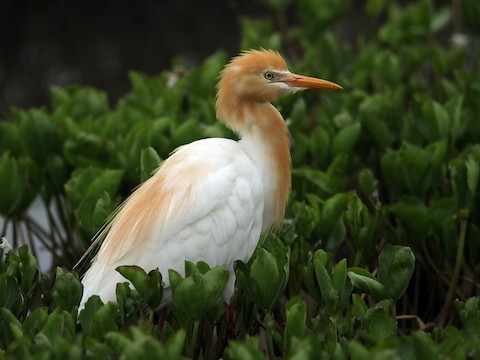
Eastern Cattle Egret in breeding plumage. (Perevoznaya, Primorskiy Kray, Russia; May 25, 2019.) © Pavel Parkhaev

Eastern Cattle Egret in breeding plumage. (Inle Lake, Shan, Myanmar; March 23, 2018.) © Cole Gaerber
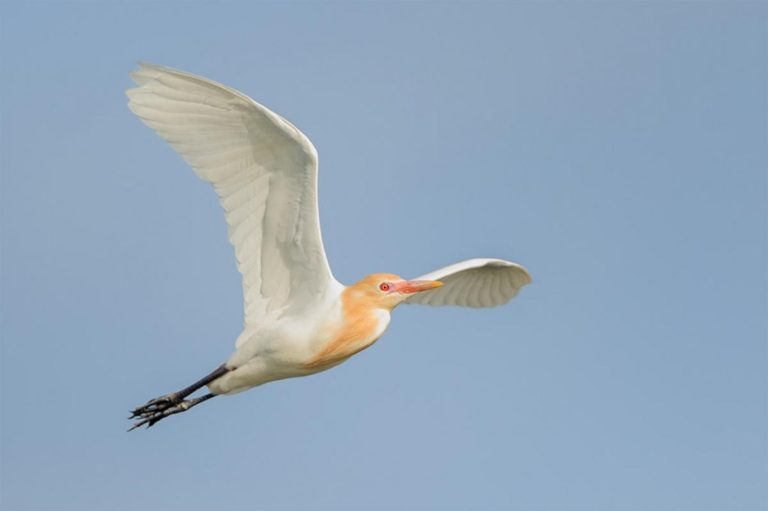
Eastern Cattle Egret in breeding plumage. (Hervey Bay, Queensland, Australia; September 2010.) © Tony Whitehead

Eastern Cattle Egret in nonbreeding plumage. (Da’an Forest Park, Taipei, Taiwan; November 18, 2019.) © Nathan Tea

Eastern Cattle Egret in nonbreeding plumage. (Waikanae Beach, North Island, New Zealand; May 2015.) © Roger Smith
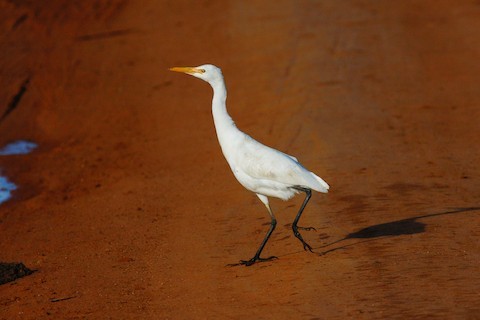
Eastern Cattle Egret in nonbreeding plumage. (Yala National Park, Sri Lanka; February 10, 2012.) © Peter Kennerley
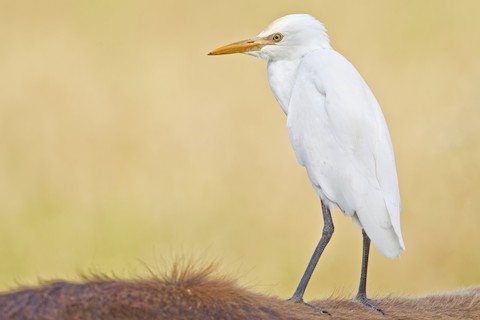
Eastern Cattle Egret in nonbreeding plumage riding a bovid. (Oxley Creek Common, Brisbane, Queensland, Australia; May 14, 2019.) © Mat Gilfedder
References
Ahmed, R. 2011. Subspecific identification and status of Cattle Egret. Dutch Birding 33:294-304.
BirdLife International. 2019. Bubulcus ibis (amended version of 2016 assessment). The IUCN Red List of Threatened Species 2019: e.T22697109A155477521. https://dx.doi.org/10.2305/IUCN.UK.2019-3.RLTS.T22697109A155477521.en. (Accessed March 15, 2022.)
Brazil, M. 2009. Birds of East Asia. Princeton University Press.
eBird. 2022. eBird: An online database of bird distribution and abundance. Cornell Lab of Ornithology, Ithaca, N.Y. http://www.ebird.org. (Accessed March 15, 2022.)
Grimmett, R., T. Roberts, and T. Inskipp. 2008. Birds of Pakistan. A & C Black Publishers Ltd., London.
Myers, S. 2009. Birds of Borneo: Brunei, Sabah, Sarawak, and Kalimantan. Princeton University Press.
Pizzey, G., and F. Knight. 2012. The Field Guide to the Birds of Australia. HarperCollins, New York.
Robson, C. 2002. Birds of Thailand. Princeton University Press.
Schofield, R. 2013. Cattle egret. In New Zealand Birds Online (Miskelly, C.M., ed.). https://nzbirdsonline.org.nz/species/cattle-egret. (Accessed March 15, 2022.)
Xeno-Canto. 2022. Eastern Cattle Egret – Bubulcus coromandus. https://xeno-canto.org/species/Bubulcus-coromandus. (Accessed March 15, 2022.)
